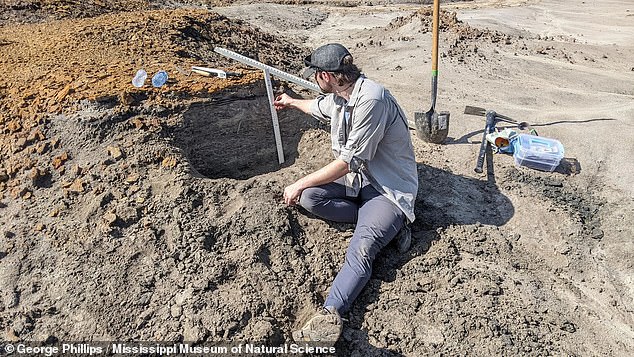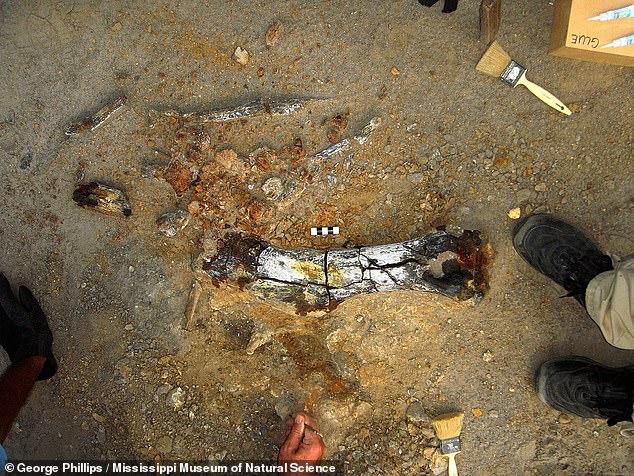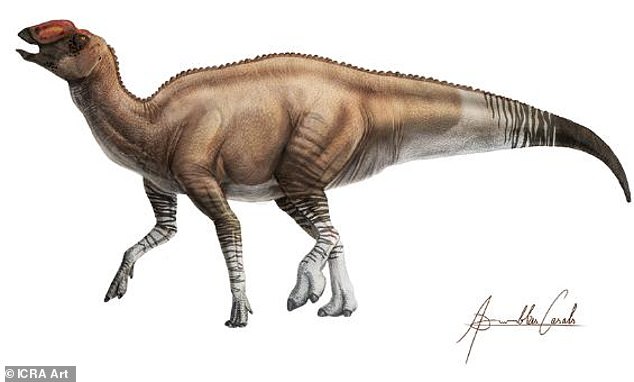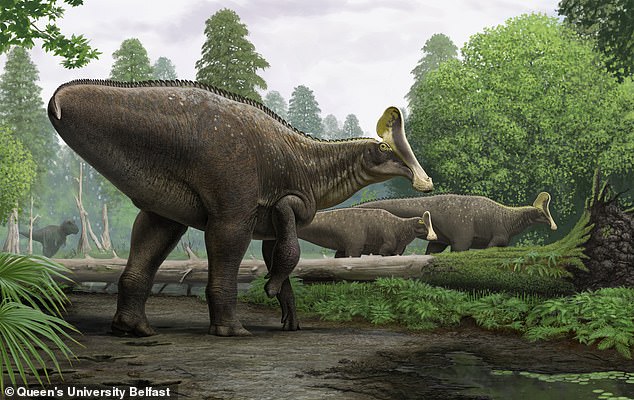The most complete dinosaur fossil ever discovered in Mississippi, called “incredibly unusual” by state officials, remains 85 percent buried since its discovery in 2007.
Paleontologists have confirmed that the specimen was once a living hadrosaur: a family of duck-billed, vegetarian dinosaurs that existed more than 82 million years ago.
But hadrosaurs are a large family of plant-eating giants, including at least 61 identified individual species and possibly hundreds of unique types that once roamed the Earth, experts say.
Researchers have managed to obtain pieces of this specimen’s spinal vertebrae, portions of its forearm, feet and pelvic bones, but the rest have proven difficult to unearth at its location outside Booneville in the northeastern part of the state.
“This was put on hold for a while because we didn’t have anybody working on it,” said James Starnes, an official with the state geology office.
Hadrosaurs are a large family of giant herbivorous dinosaurs, including at least 61 identified individual species and possibly hundreds of unique types that once roamed the Earth, according to experts. The hadrosaurs above are an artist’s reconstruction of a Russian find

The most complete dinosaur fossil ever discovered in Mississippi is now known to belong to the hadrosaur family, but only 15 percent of it has been safely unearthed. Researcher Derek Hoffman (above) is turning to 3D forensic bone analysis to figure out the exact species of hadrosaur.
For nearly two decades, it has remained a mystery which of the many species of hadrosaur was actually the type unearthed in this find in the Booneville, Mississippi area.
But researchers are now turning to a 3D method of forensic bone analysis to solve the mystery before it is fully unearthed.
Derek Hoffman, a graduate student in geology at the University of Southern Mississippi (USM), is now analyzing the hadrosaur remains using this method, known in multiple scientific disciplines as “geometric morphometrics.”
“What geometric morphometrics does,” as Hoffman simplified it, “is take a shape analysis approach.”
Key features or “landmarks” are determined for a given bone sample and then their respective distances and the ratios of those distances are compared using complex statistical models to confirm differences and similarities to known bones.
The method has also proven effective in anthropology, as well as in studies of human evolution, including comparisons between the brain cavities of Modern humans and our Neanderthal ancestors.
But Hoffman’s search for answers about this hadrosaur fossil has been made more difficult by the fact that some pieces of the creature are in the hands of private collectors.

Above, the upper arm bone of an ancient hadrosaur discovered in northeastern Mississippi.
Hoffman’s work focuses primarily on bones held by the Mississippi Museum of Natural Sciences.
“We have quite a few vertebrae,” the museum’s curator of paleontology, George Phillips, told the local newspaper. Clarion Ledger‘We have a humerus.’
“We have an ulna. The ulna is the back of the forearm.”
“We have some foot bones,” Phillips continued. “Then we have the pubis.”
The ulna of an adult hadrosaur is about 60 centimetres long and the humerus is about 40 centimetres long. And the foot bones of a complete adult hadrosaur alone can weigh more than 23 kilograms.
But to the frustration of researchers, the dinosaur’s skull — the most unique identifying feature for differentiating between hadrosaur species — has yet to be located.
Different species of hadrosaurs are known to have evolved a wide and bizarre variety of crowns on their duck-billed heads, including ones made of flexible material like the red “comb” of a rooster.
Paleontologists still debate what biological purpose these unusual and sometimes ostentatious features might have served, but their variety has contributed to the recorded diversity of the hadrosaur family.
Hoffman at USM has focused on the dinosaur’s pubis, a bone at the front of the pelvis, as the next best bet for identifying the fossil’s species.
While the differences between the pubic bones of hadrosaur species are subtle, often too subtle for the naked human eye, their hidden distinctions can be uncovered through rigorous mathematical approaches such as geometric morphometrics.
The USM geology graduate student hopes to at least narrow down the number of possible hadrosaur species this Mississippi fossil could be.
Or, “What’s the lowest level of taxonomy we can go with this hadrosaur?” as Hoffman put it.
What is now known about this particular hadrosaur is that it was probably between 25 and 26 feet long and about 16 feet tall when standing on its hind legs.

According to Hoffman, hadrosaurs, as a family of species, are “certainly the best-represented dinosaurs in the fossil record.” Pictured: An artist’s impression of another duck-billed dinosaur from this group, one from 80 million years ago discovered near Texas.
Although researchers believe the hadrosaur lineage began in North America, the herbivores eventually migrated around the world, with fossils discovered in Asia, South America, Europe, and North Africa.
“They are the best represented dinosaurs in the fossil record,” Hoffman said, “without a doubt.”
The name hadrosaur derives from the ancient Greek for ‘robust lizard’, and heavy animals did indeed range between about 2.2 to 4.4 US tons (or 2,000 to 4,000 kilograms).
Many species of hadrosaurs lived between 75 and 65 million years ago in the Late Cretaceous Period.
Other examples of dinosaurs from the hadrosaur family include the Parasaurolophuswhich had a long, backward-curving crest on its head and appears in the 2022 film ‘Jurassic World Dominion’, and the Edmontosauruswhich had the aforementioned crest made of soft tissue like a rooster.
State official James Starnes of the Mississippi Department of Environmental Quality’s Bureau of Geology said the discovery of this hadrosaur in 2007 near Booneville was simply “Incredibly unusual.’
“We don’t have a lot of skeletons,” Starnes said. “We have pieces and parts, but not a skeleton.”
Starnes hopes that despite the nearly two decades it has taken to unearth just a fraction of this hadrosaur fossil, the project will one day be completed.
“We’re still getting more out of this specimen,” Starnes said.

